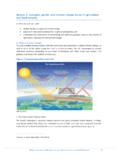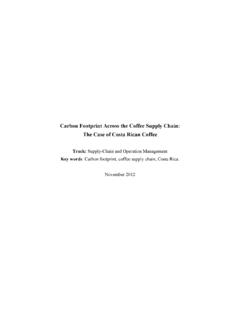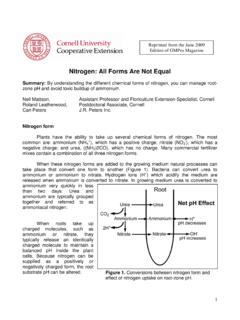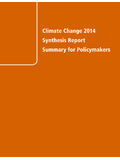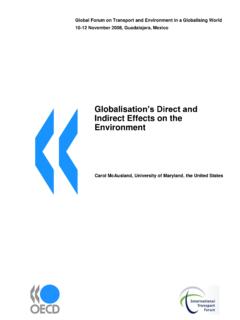Transcription of Climate change and human health - WHO
1 Climate change andhuman healthRISKS AND McMichaelThe Australian National University, Canberra, Campbell-LendrumLondon School of Hygiene and Tropical Medicine, London, United Corval nWorld health Organization, Geneva, EbiWorld health Organization Regional Office for Europe, European Centre forEnvironment and health , Rome, GithekoKenya Medical Research Institute, Kisumu, ScheragaUS Environmental Protection Agency, Washington, DC, USAA. WoodwardUniversity of Otago, Wellington, New ZealandWORLD health ORGANIZATIONGENEVA2003 WHO Library Cataloguing-in-Publication DataClimate change and human health : risks and responses / editors : A. J. McMichael ..[et al.] effect disasters rays adverse effects assessment , Anthony 92 4 156248 X(NLM classification: WA 30) World health Organization 2003 All rights reserved.
2 Publications of the World health Organization can be obtained from Marketing and Dis-semination, World health Organization, 20 Avenue Appia, 1211 Geneva 27, Switzerland (tel: +41 22 791 2476;fax: +41 22 791 4857; email: Requests for permission to reproduce or translate WHOpublications whether for sale or for noncommercial distribution should be addressed to Publications, at theabove address (fax: +41 22 791 4806; email: designations employed and the presentation of the material in this publication do not imply the expressionof any opinion whatsoever on the part of the World health Organization concerning the legal status of anycountry, territory, city or area or of its authorities, or concerning the delimitation of its frontiers or lines on maps represent approximate border lines for which there may not yet be full mention of specific companies or of certain manufacturers products does not imply that they are endorsedor recommended by the World health Organization in preference to others of a similar nature that are not men-tioned.))
3 Errors and omissions excepted, the names of proprietary products are distinguished by initial World health Organization does not warrant that the information contained in this publication is completeand correct and shall not be liable for any damages incurred as a result of its publication contains the collective views of an international group of experts and does not necessarily rep-resent the decisions or the stated policy of the World health Organization, the World Meteorological Organiza-tion, or the United Nations Environment in New ZealandTypeset in Hong KongPrinted in MaltaPrefaceixAcknowledgementsxiChapter 1. Global Climate change and health : an old story writ large1 Introduction1 Recognising the complexity of systems upon which life depends: an ecological perspective3 Climate change : overview of recent scientific assessments5 Climate and human health : an ancient struggle8 Potential health impacts of Climate change10 Population vulnerability and adaptive responses12 Conclusions14 References15 Chapter 2.
4 Weather and Climate : changing human exposures18 Introduction18 The Climate system and greenhouse gases19 Weather, Climate and Climate variability24 Climate change26 Climate variability and change over the twentieth century29 Special report on emission scenarios30 Anthropogenic Climate change31 Climate modelling33 Exposure Assessment36 Conclusions39 References40 Chapter 3. International consensus on the science of Climate and health : the IPCC Third Assessment Report43 Introduction43 The IPCC43 The effects of Climate on the transmission biology of human diseases45 IPCC Third Assessment Report47 Direct effects on health47 Indirect effects on health48iiiContentsAssessments of health impacts by IPCC region51 Africa51 Asia52 Australia and New Zealand52 Europe53 Latin America54 North America55 Polar regions56 Small Island States56 Post-TAR assessments56 Conclusions56 References57 Chapter 4.
5 Looking to the future: challenges for scientists studying Climate change and health61 Introduction61 Tasks for public health scientists63 Establishing baseline relationships63 Seeking evidence for early health effects of Climate change 64 Developing scenario-based models (future effects)66 Evaluating adaptation options68 Estimating ancillary benefits and costs70 Informing policy70 Recognizing and responding to uncertainty71 General issues concerning uncertainty74 Conclusions75 References76 Chapter 5. Impacts on health of Climate extremes79 Introduction79El Ni o and infectious diseases81 Malaria82 Dengue83 Rodent-borne diseases84 Diarrhoeal illness85 Temperature extremes: heatwaves and cold spells86 The impact of heatwave events on mortality87 Vulnerability to temperature-related mortality89 Winter mortality89 The potential impact of Climate change on temperature related mortality90 Natural disasters90 Trends in weather disasters91 The health impacts of disasters92 Conclusions95 References96 Chapter 6.
6 Climate change and infectious diseases103 Introduction103ivCLIMATE change AND human HEALTHD isease classifications relevant to Climate / health relationships105 Directly transmitted diseases105 Indirectly transmitted diseases (anthroponoses & zoonoses)106 Climate sensitivity of infectious disease107 Seasonality of infectious disease107 Vector-borne diseases108 Water-borne diseases109 Documented and predicted Climate /infectious disease links111 Historical evidence of Climate /infectious disease links111 Early indicators for long-term trends in global warming114 Predictive modelling115 Modifying influences121 Sociodemographic influences121 Environmental influences122 Conclusions and recommended future steps126 References127 Chapter 7. How much disease could Climate change cause?133 Introduction133 General methods134 Disease burdens and summary measures of population health134 Estimating burden of disease attributable to a risk factor134 Type of evidence available for estimating disease burden due to Climate change135 Definition of risk factor and exposure scenario137 Methods for estimating exposure to Climate change138 Outcomes to be assessed139 Methods for estimating risk factor-disease relationships140 Specific health impacts141 Direct physiological effects of heat and cold on cardiovascular mortality141 Diarrhoeal disease143 Malnutrition145 Natural disasters caused by extreme weather and sea level rise147 Falciparummalaria150 Aggregated estimates for 2000152 Conclusions153 References155 Chapter 8.
7 Stratospheric ozone depletion, ultraviolet radiation and health159 Introduction159 The Montreal Protocol noticing and responding to ozone depletion160 Difference between stratospheric ozone depletion and human -enhanced greenhouse effect161 CONTENTSvSolar UVR measurement162 Main types of health impacts163 Disorders of the skin163 Eye disorders167 Immune system function and immune-related disorders169 Public health message re UVR exposure174 Conclusions175 References176 Chapter 9. National assessments of health impacts of Climate change : a review181 Introduction181 health impact assessments: key concepts and methods182 Methods for Climate - change impact assessments183 Review of national health assessments185 Developed countries187 Developing countries190 Small island developing states191 Recommendations for developing methods and tools192 Literature reviews192 Predictive modelling193 Use of Climate scenarios194 Integrated assessment194 Integration between sectors194 Integration across a region195 Adaptation assessment196 Review of National Communications to the United NationsFramework Convention on Climate Change197 Conclusions199 References200 Chapter 10.
8 Monitoring the health effects of Climate change204 Introduction204 Methodological considerations204 Evidence of Climate change204 Attribution205 effect modification206 General principles207 Evidence of Climate sensitivity207 Public health burden207 Practicality207 Data requirements and data sources208 Meteorology208 health markers209 Other explanatory factors210 Examples211 Vector-borne disease213 Diarrhoeal illness215 Conclusions216 References218viCLIMATE change AND human HEALTHC hapter 11. Adaptation and adaptive capacity in the public health context220 Introduction220 Adaptation220 Adaptation, Climate impacts, and vulnerability assessment 221 Adaptation and prevention222 Coping with climate223 Adaptive capacity225 Determinants of adaptive capacity226 Economic resources226 Technology227 Information and skills228 Infrastructure229 Institutions230 Equity230 health status and pre-existing disease burdens231 Research needs231 Conclusions233 References233 Chapter 12.
9 From science to policy: developing responses to Climate change237 Introduction237 Boundaries between assessment and policy formation240 Decision-making criteria240 Decision-support tools241 Response options241 Case Study 1: Hantavirus pulmonary syndrome in the south-western United States of America242 Building the bridge from science to policy: policy-focusedassessment244 Assessment as a multidisciplinary activity245 Stakeholder engagement246 Evaluation of adaptation options247 Case Study 2: Preparing for a changing Climate in the Great Lakes region248 Case Study 3: Hot weather watch/warning systems250 Characterization of uncertainties253 Case Study 4: human dependence on food from coral reef fisheries254 Case Study 5: Dengue simulation modelling and risk reduction258 Formulating a research agenda259 Increasing public awareness: importance of communicating assessment results261 Conclusions262 References263 CONTENTSviiChapter 13.
10 Conclusions and recommendations for action267 Introduction267 Conclusions and recommendations271 Climate related exposures271 Reaching consensus on the science273 Remaining challenges for scientists274 Extreme Climate events274 Infectious diseases275 The burden of disease276 Stratospheric ozone depletion, Climate change and health 277 National assessments277 Monitoring Climate change impacts on human health278 Adapting to Climate change278 Responses: from science to policy280 Concluding remarks281 References282 Glossary284 Index306viiiCLIMATE change AND human HEALTHT here is now widespread consensus that the Earth is warming at a rate unprece-dented during post hunter-gatherer human existence. The last decade was thewarmest since instrumental records began in the nineteenth century, and con-tained 9 of the 10 warmest years ever recorded.










